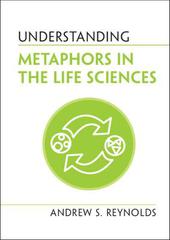
|
Understanding Metaphors in the Life Sciences
Hardback
Main Details
| Title |
Understanding Metaphors in the Life Sciences
|
| Authors and Contributors |
By (author) Andrew S. Reynolds
|
| Series | Understanding Life |
|---|
| Physical Properties |
| Format:Hardback | | Pages:166 | | Dimensions(mm): Height 185,Width 133 |
|
| Category/Genre | Philosophy of science
History of science
Life sciences - general issues
Genetics (non-medical) |
|---|
| ISBN/Barcode |
9781108837286
|
| Classifications | Dewey:570 |
|---|
| Audience | | Tertiary Education (US: College) | |
|---|
| Illustrations |
Worked examples or Exercises; 15 Line drawings, black and white
|
|
Publishing Details |
| Publisher |
Cambridge University Press
|
| Imprint |
Cambridge University Press
|
| Publication Date |
28 April 2022 |
| Publication Country |
United Kingdom
|
Description
Covering a range of metaphors from a diverse field of sciences, from cell and molecular biology to evolution, ecology, and biomedicine, Understanding Metaphors in the Life Sciences explores the positive and negative implications of the widespread use of metaphors in the biological and life sciences. From genetic codes, programs, and blueprints, to cell factories, survival of the fittest, the tree of life, selfish genes, and ecological niches, to genome editing with CRISPR's molecular scissors, metaphors are ubiquitous and vital components of the modern life sciences. But how exactly do metaphors help scientists to understand the objects they study? How can they mislead both scientists and laypeople alike? And what should we all understand about the implications of science's reliance on metaphorical speech and thought for objective knowledge and adequate public policy informed by science? This book will literally help you to better understand the metaphorical dimensions of science.
Author Biography
Andrew S. Reynolds is Professor of Philosophy at Cape Breton University, Canada. He is the author of The Third Lens: Metaphor and the Creation of Modern Cell Biology (University of Chicago Press, 2018) and Peirce's Scientific Metaphysics: The Philosophy of Chance, Law and Evolution (Vanderbilt University Press, 2002). He has a PhD in the philosophy of science from the University of Western Ontario.
Reviews'What a timely book this is! It is precisely because biology has made such striking advances in recent years that its stock of metaphors is due for a clinical check-up. Reynolds offers a reliable and perceptive diagnosis of the framing narratives of the life sciences, sympathetically examining their strengths and weaknesses. This book should be an essential accompaniment to any study course in the biological sciences.' Philip Ball, science writer and author of How to Grow a Human 'In this beautifully written, highly accessible, and captivating work, Reynolds reveals the incredible extent to which scientific methods and descriptions in biology, the life sciences, and medicine are infused with metaphors. Interweaving the rich history and philosophy of the uses of these metaphors over time, their many implications for scientific reasoning, understanding, and the ethical and political dimensions of science itself are perceptively explored, with wonderful clarity and across an encyclopedic range of examples. Metaphors afford telling insight, opening doors to further inquiry and closing others. Is your genome software? Are enzymes molecular machines? Does nature select some traits over others, thereby constructing the tree of life? The fascinating world of metaphors in science comes to life on every page.' Anjan Chakravartty, University of Miami, USA 'I read Lakoff and Johnson's book Metaphors We Live By in the 1980s, and it was eye opening. Andrew Reynolds' book, which should be called Metaphors Science Lives By, is equally eye opening. Metaphors shape the way we live in the world. In science, they shape the way we understand the world. This can have huge implications for our lives, for better or for worse. How does this process of understanding work, especially in the life sciences? This book deals with the essential role of metaphors in this process. Written in an admirably clear style, Reynolds makes us aware of the power of metaphor, but also its dangers and pitfalls. It is an essential read for everybody interested in understanding how science and science communication work with and through metaphors. Importantly, it also dispels some common misunderstandings about the role of metaphors in science.' Brigitte Nerlich, University of Nottingham, UK 'Understanding Metaphors in the Life Sciences takes us from genes to cells, and up to the vast evolutionary tree of life, showing how science depends overwhelmingly on metaphor for understanding, for advance, for communication. A very important book.' Michael Ruse, Florida State University, USA
|